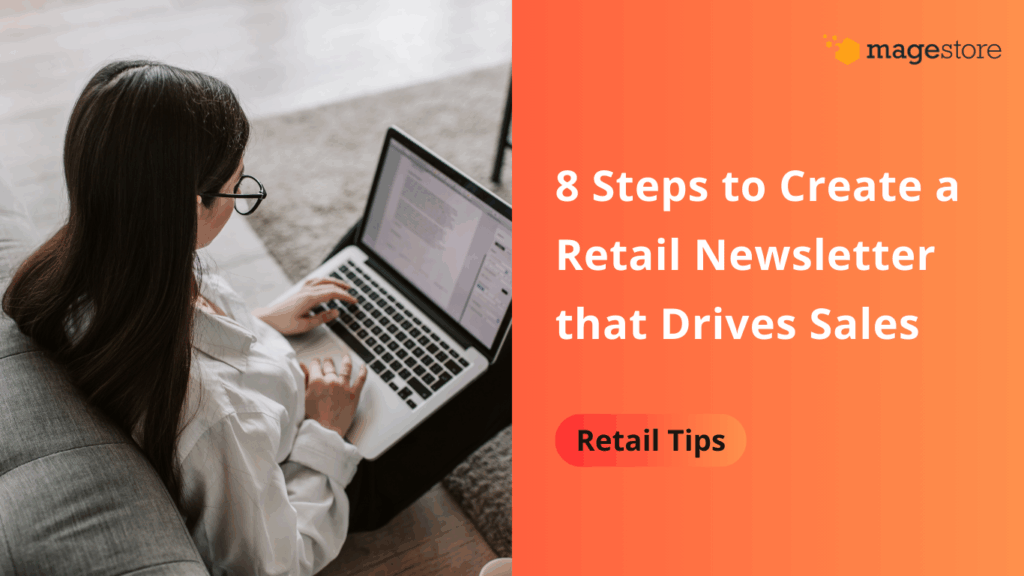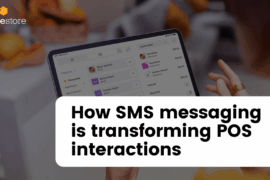A retail newsletter is one of the best ways to build customer relationships, boost loyalty, and drive sales.
In case you don’t know, 96% of the people landing on your website are never ready to buy. Unless you have a strategy for reaching these potential customers and staying in touch with them, you will never be able to close those sales.
A newsletter provides a unique opportunity to engage with these customers and keep your brand at the forefront of their minds.
But your newsletter strategy must be spot on to achieve that.
This article will share actionable steps on how to create a retail newsletter. Let’s get started.
Why retailers need a newsletter
Major retailers like Amazon, Sephora, Casper, and Macy’s are always keen to capture users’ email addresses. Some of these stores even offer exclusive discounts to users who sign up for their newsletters, as you can see below.
Here is why these retailers go out of their way to create and grow their newsletters, and why you should do the same:
- Build a direct relationship with retailers
An email newsletter is one of the few channels that allows you to connect directly with your target audience. Just think about it. You could create a beautiful, super-engaging website, but its visibility is significantly influenced by Google’s algorithms.
You could also have a superb social media marketing campaign. However, your organic visibility still depends on each platform’s algorithms.
A newsletter gives you direct access to your customers. As long as you’re following email marketing deliverability best practices, your messages will always hit the recipients’ inboxes. This means you’ll always have a reliable channel through which you can engage with customers and promote your products.
- Boost sales
Newsletters are incredibly effective at driving sales. The channel also offers a high return on investment, with reports showing an ROI of 3,600%, which is significantly higher than what you can achieve with SEO, display ads, and other channels.
Newsletter campaigns for new product launches, promotional codes, flash sales, upsells and cross-sells, cart abandonment campaigns, and winback emails can help you generate revenue for your retail store.
Moreover, some of the best email marketing tools, like GetResponse and Klaviyo, support personalized automations at scale. These tools can track user behavior on your site and their interactions with your newsletter. They’ll then send emails with personalized product recommendations that are more likely to convert.
- Gather customer insights and feedback
You can use newsletters to collect customer feedback on autopilot. Newsletter tools allow you to create customer feedback request workflows that can be deployed a few days after a product is marked as delivered.
Those emails will collect valuable customer feedback that will help you improve your products and the overall customer experience.
An AI client sentiment analysis tool can help you automatically interpret open‑ended survey responses and flag recurring themes. This allows you to prioritize improvements without having to review every comment manually.
- Drive traffic to both online and offline stores
You can also use a newsletter to drive foot traffic to your store and online traffic to your store. Campaigns such as new product launches can create hype and demand for a new product even before it launches.
You can also use the newsletter to promote seasonal offers like Thanksgiving, Black Friday, Cyber Monday, and Christmas campaigns.
How to create a retail newsletter
Here is an 8-step guide on creating a retail newsletter.
1. Analyze the business goals of your newsletter
What business objectives do you want to achieve with the newsletter? Answering this question is the first step to creating a successful retail newsletter.
The answer will set the course of action for everything else, like choosing the right newsletter platform, curating the newsletter content, and even identifying the metrics for success.
Therefore, start by identifying and describing the specific things you want to achieve with the newsletter. The typical newsletter goals are:
- Educate prospects about your products and brand
- Generate sales
- Boost customer lifetime value
- Collect customer feedback
It’s okay to have more than one goal. You can pursue several goals by simply creating different newsletter campaigns and segmenting your email list where necessary.
So, identify and prioritize the goals. It also helps to know the specific metrics or KPIs that will help you track each goal. For example, conversion rates and revenue per campaign are effective metrics for tracking the revenue or sales your newsletters generate.
Meanwhile, repeat purchase rate and average order value from subscribers can tell you whether your newsletter is doing a good job of boosting CLV.
2. Identify a suitable email newsletter platform
Once you know the goals, look for an email newsletter platform that can help you hit those goals. There are plenty of email newsletter solutions available on the market today. Identify one that gives you the best value for your money.
The ideal platform will have retail email newsletter templates you can customize. It will also have an easy-to-use email editor. This ensures that you can edit and customize your newsletters, even if you’re not a designer.
Source: GetResponse
Other critical features are email automation, audience segmentation, and personalization. Pick a platform with an easy-to-use email automation builder, advanced audience segmentation options, and scalable personalization features.
Some of the newsletter platforms you may want to consider are Omnisend, GetResponse, and Klaviyo. Most of these platforms also offer free trials you can use to test the tools and see if they align with your needs.
3. Segmentation of audiences
The next step is to create relevant audience segments that will help you hit your business goals.
If the intention is to educate customers about your products, you’ll need to have a separate segment for new subscribers and loyal customers. Loyal customers already know quite a bit about your business, so they won’t need as many educational emails as new subscribers.
Let’s say you want to boost CLV. In that case, you may want to create a separate segment for your most loyal customers. You can then target these customers with a tailored newsletter that covers topics such as loyalty programs, product bundle promotions, and early access offers.
Look at the business goals you have in mind, and consider the audience segments you’ll need to hit those goals. The best email newsletter platforms will provide some guidance on the segments you can create based on your specified goals. These platforms will also help you automate audience segmentation so you can focus on more strategic tasks like coming up with campaign ideas.
4. Adapt a suitable design template
At this point, you want to look for a design template that aligns with your newsletter’s goal. A newsletter focusing on educational content may need more text blocks than a promotional newsletter, for example. This is why it is so important to pick a platform with a diverse range of templates.
After identifying a suitable template, customize it to ensure it aligns with your branding needs. This is where an intuitive newsletter editor becomes invaluable.
Edit the colors, font, padding, and other design elements to maintain branding consistency.
5. Design and map content
It’s time to design your newsletter content. The content will depend on the goal of each email campaign.
Consider a promotional newsletter where the objective is to promote a seasonal sale. This newsletter will require a brief description of the sale, images to showcase the products on offer, discount codes or offers, and CTAs directing users to the product or product listings eligible for the offers.
On the other hand, think about an educational email. This newsletter will need slightly more text to educate the recipients. It can then include a CTA to a blog post or page where they can learn more about the subject.
Luckily, content creation is no longer a headache, as most newsletter platforms provide templates for various types of campaigns. They also offer built-in AI tools to help with content creation.
6. Create a content calendar
A content calendar keeps your newsletter strategy streamlined. It also helps you anticipate major campaigns and create compelling content that drives the best results.
Start by identifying key dates and days on your calendar. For example, Valentine’s Day, Black Friday, Cyber Monday, and Thanksgiving are key dates for most retailers. Map these dates on the calendar first.
Next, identify dates that are vital for your business. For example, a new product launch is vital. You need to identify this date in advance so that you can start sending related newsletters to build the hype several days or weeks before the launch.
After this, you should be left with the open dates or weeks where you can now get creative and decide on the theme for those newsletters. For example, if there’s no major event for the month of April, you can come up with a special newsletter theme for that month.
Something else you’ll need to figure out here is your newsletter cadence. How often do you want users to receive your newsletter? Research shows that sending 1-2 newsletters per week gets the best open and click rates.
Lastly, remember to vary your newsletter content. Don’t send promotional newsletters back-to-back for an entire month. Combine educational newsletters with some promotional emails to keep your recipients engaged.
7. Ensure legal compliance
Email gives you direct access to your target audience as long as you follow the relevant guidelines. Data protection laws like GDPR and CCPA are in place to protect users from unsolicited emails, for example. That means if you buy an email list, you risk getting penalized and having your domain blocked.
The best newsletter solutions have set up the right measures in place to help you comply with GDPR and CCPA regulations. This will keep you safe from penalties and stop your emails from landing in the spam folder, instead of the primary inbox.
8. Track metrics and improve
Finally, track your newsletter performance and make the necessary improvements. Go back to the metrics you identified in the first step when setting your newsletter goals. Monitor those metrics over time to determine whether your newsletter strategy is meeting its goals.
You may also want to run A/B tests or split tests to optimize your campaigns. For example, experiment with different audience segments, offers, newsletter send times and frequency, email content, and subject lines. These tests help you get maximum ROI from each campaign.
In closing
A retail newsletter provides a great way to stay in contact with your potential and existing customers. An effective newsletter strategy will boost brand awareness, increase sales, and enhance customer loyalty.
This article covered the eight steps you should follow to create a retail newsletter. Follow the guide to turn your email list into a sales and engagement channel for your business.
Are you in the market looking for a POS for Magento? If so, Magestore offers a retail POS that helps you deliver pleasant omnichannel experiences to your customers. Discover how Magestore can support your retail business here.




